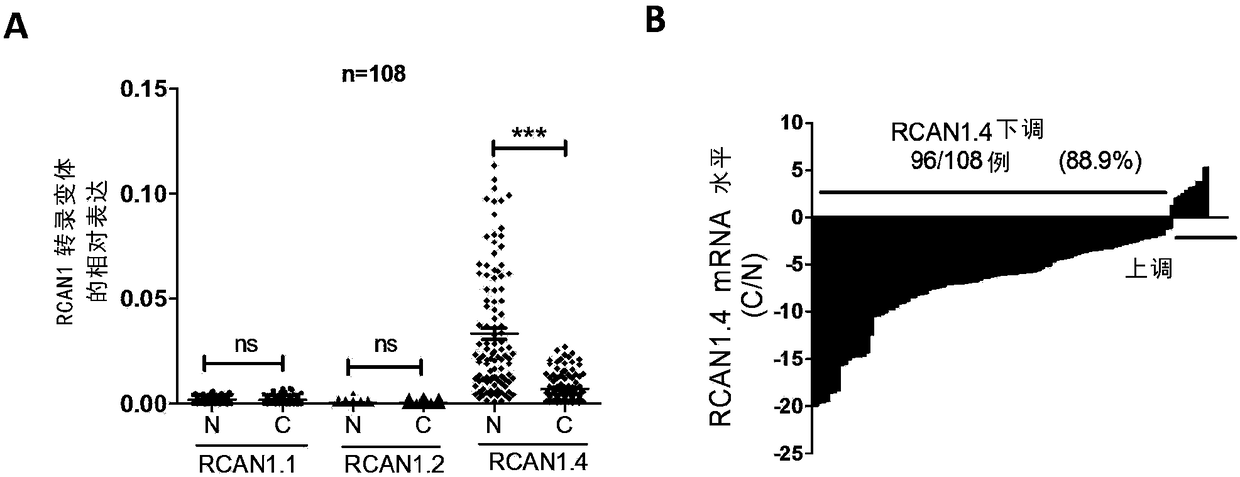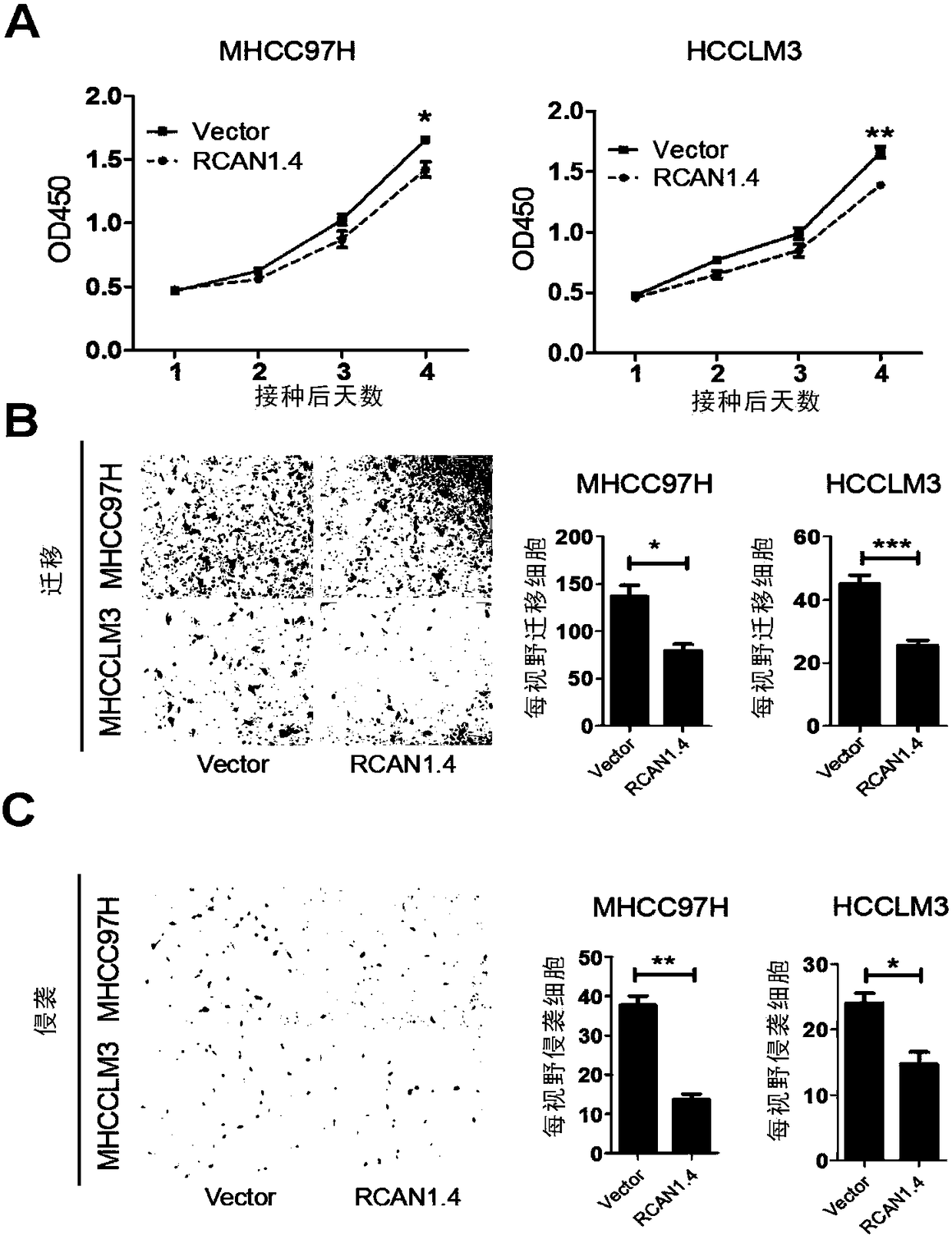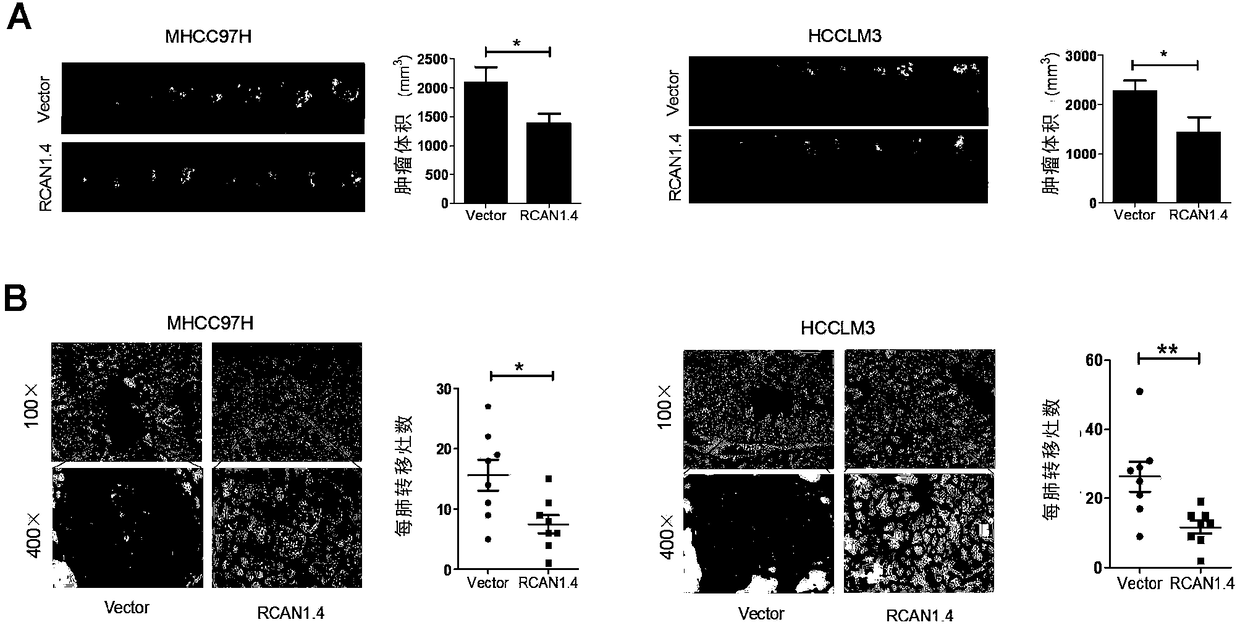Applications of regulator of calcineurin 1.4 or analogues thereof in preparing medicines for inhibiting liver cancer
A technology of calcineurin and regulatory protein, applied in the field of biomedicine, can solve problems such as unclear function of liver cancer
- Summary
- Abstract
- Description
- Claims
- Application Information
AI Technical Summary
Problems solved by technology
Method used
Image
Examples
Embodiment 1
[0188] Example 1. The expression level of RCAN1.4 in tumor tissue was significantly down-regulated
[0189] There are three detectable alternative splice forms of RCAN1 in mammalian tissues (RCAN1.1, RCAN1.2 and RCAN1.4). Through quantitative PCR detection of 108 pairs of liver cancer tissues (Cancerous tissues from human hepatocellular carcinomas, referred to as C) and paired non-cancerous liver tissues (abbreviated as N) collected by Dongfang Hepatobiliary Hospital, it was found that: and RCAN1.2 mRNA expression levels in liver cancer tissues and paired paracancerous liver tissues were extremely low, and there was no statistical difference ( figure 1 , A); The expression level of RCAN1.4mRNA in the non-cancerous liver tissue was very high, while it was significantly down-regulated in the paired liver cancer tissue samples ( figure 1 , A), the minimum down-regulation multiple is about 20 times ( figure 1 , B), wherein the number of cases whose expression was down-regulated ...
Embodiment 2
[0191] Example 2. Increasing the expression of RCAN1.4 can inhibit the proliferation, migration and invasion of liver cancer cells in vitro
[0192] In order to study the effect of RCAN1.4 on the function of liver cancer cells in vitro, the inventors used lentiviral transfection to construct RCAN1.4 overexpression stable cells and their control cells (MHCC97H and HCCLM3) in liver cancer cells, and detected the proliferation of liver cancer cells in vitro , changes in migration and invasion capabilities.
[0193] The results of CCK-8 experiment showed that after overexpression of RCAN1.4, the proliferation ability of liver cancer cells was significantly reduced ( figure 2 , A).
[0194] The results of cell migration experiments showed that after overexpression of RCAN1.4, the migration ability of liver cancer cells was significantly reduced ( figure 2 , B).
[0195] The results of Matrigel cell invasion assay showed that after overexpression of RCAN1.4, the invasion abilit...
Embodiment 3
[0197] Example 3. Overexpression of RCAN1.4 can effectively inhibit the progression of liver cancer
[0198] In order to study the effect of RCAN1.4 on the growth and metastasis of liver cancer cells in vivo, the inventors used lentiviral transfection to construct RCAN1.4 overexpression stable cells and their control cells (MHCC97H and HCCLM3) in liver cancer cells, and established nude mice Liver orthotopic tumorigenesis model.
[0199] In nude mouse liver orthotopic tumorigenesis model, the liver was orthotopically inoculated with hepatocellular carcinoma cells (MHCC97H-RCAN1.4 and HCCLM3-RCAN1.4) and control cells (MHCC97H-Vector and HCCLM3-Vector) overexpressing RCAN1.4, After feeding for a certain period of time, the orthotopic liver tumors of the nude mice were collected, and the volume of the liver tumors in each group was calculated. At the same time, HE staining was performed on the lung tissues of each group to count the number of lung metastases.
[0200] The resul...
PUM
 Login to View More
Login to View More Abstract
Description
Claims
Application Information
 Login to View More
Login to View More - R&D
- Intellectual Property
- Life Sciences
- Materials
- Tech Scout
- Unparalleled Data Quality
- Higher Quality Content
- 60% Fewer Hallucinations
Browse by: Latest US Patents, China's latest patents, Technical Efficacy Thesaurus, Application Domain, Technology Topic, Popular Technical Reports.
© 2025 PatSnap. All rights reserved.Legal|Privacy policy|Modern Slavery Act Transparency Statement|Sitemap|About US| Contact US: help@patsnap.com



